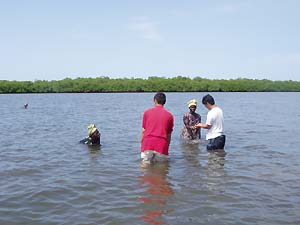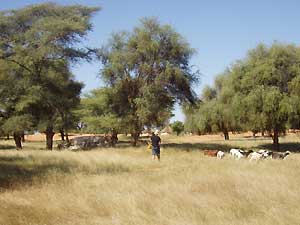| Period: 17 October - 10 November 2003. Country: Ethiopia, Senegal |
| |
Purpose of the Visit |
| |
Workshop in Ethiopia and On-Site Education in Senegal |
| |
ICHIKAWA Mitsuo (ASAFAS: Division
of African Area Studies) |
| |
Record of Activities |
| |
10/17 (Fri) |
 |
Leave Osaka – Arrive in Paris |
| |
10/18 (Sat) |
 |
Leave Paris – Arrive in Addis Ababa (via Rome)
(on the 19th) |
| |
10/20 (Mon) – 27 (Mon) |
 |
Participate in the workshop of the 21st Century COE Program
held at Addis Ababa University, and study tour to Bahir Dahl and Gonder |
| |
10/28 (Tue) |
 |
Leave Addis Ababa – Arrive in Paris (via Rome) |
| |
10/29 (Wed) |
 |
Leave Paris – Arrive in Dakar |
| |
10/30 (Thu) – 11/1 (Sat) |
 |
Collection of materials and preparation for visit to the students’ research
sites at Dakar |
| |
11/2 (Sun) |
 |
Leave Dakar – Arrive in Djifer |
| |
11/3 (Mon) |
 |
Djifer to Falia and back to Djifer: Conduct research and on-site
education concerning Serer fishing people in the mangrove area around Falia |
| |
11/4 (Tue) – 11/7 (Fri) |
 |
Visit Djifer – Thies – Touba – Dara – Richard
Toll – St. Louis:
Carry out comparative study and on-site education concerning the interactive
relationship between humans and vegetation |
| |
11/8 (Sat) – 11/9 (Sun) |
 |
Dakar: Visit Museum of IFAN (Institut Fondamental d’Afrique
Noire) to gather materials |
| |
11/10 (Man) |
 |
Leave Dakar – Arrive at Paris (on November 11)
After participating in an international symposium in Paris (with a different
fund), return to Japan on November 18. |
| |
Outcome
and Progress Report |
| |
The research and the on-site-education in Senegal involved a study on a
fishing community near a mangrove forest reserve in the western
coastal district, as well as a study on the interactive relationships between
humans and vegetation in the Acacia savanna area in the southern part of
the Sahel region.
The
research and studies on Africa of ASAFAS once focused on the former British
colonies such as Tanzania, Kenya and Zambia in East Africa, but in recent
years researches have been actively conducted in Francophone countries in
West Africa such as Burkina Faso and Senegal. During this trip I visited
the research sites of Masaaki HIRAI (Year of enrollment: 2001) and Hiraku USUI (Year of enrollment: 2002), both graduate students
at ASAFAS, who are conducting research on the utilization of the environment
and social changes of the different groups of the Serer, one of Senegal’s
major ethnic groups, and discussed with them their problems and how to continue
with their studies.
HIRAI has been conducting
a survey on historical changes in the woodland vegetation dominated by
Acacia albida in the habitat of the Serer-Sin
in the central part of Senegal. Though this area is arid, with annual precipitation
of 400-600 mm, it has a high population density of several hundred persons
per 1 km, thanks to the combination of cereal cultivation, mainly of pearl
millet, with cattle farming. Moreover the villagers are said
to have lived on the same site for more than 200 years. Considering that
the capacity to support such a high population and stable
farming lies in the vegetation dominated by Acacia albida, HIRAI has been
investigating the process of development of this vegetation and its recent
changes. During this trip, we toured areas where there is a particularly
high distribution of this vegetation to study the human-vegetation interaction.
We also conducted comparative research with the surrounding area where
the
vegetation is dominated by Acacia tortilis.
USUI has just begun
a survey in a fishing community of Serer-Niominka, who live in the coastal
mangrove area, and intends to carry out research on the relationship between
coastal fishing and mangrove forests, as well as the current status and development
of “migrant fishing” to remote areas, which has become common
in recent years. During this trip, we visited fishing communities around USUI’s
survey area and explored ways to gain a comprehensive understanding of environmental
changes in mangrove forests and waters and in coastal fishing caused by aridification
and development projects, as well as the great increase in migrant fishing
to remote areas. |
| |
Future Tasks |
| |
Because the recent visit to Senegal was very short, I had
to focus on the areas where our graduate students are doing research, and
keep the discussions with related institutions to a minimum.
One of these institutions is the Institut Fondamental d’Afrique Noire
(IFAN) in Senegal, which has a long history of cultural and social studies
of West Africa, but due to the limited time I could only visit its museum.
Academic exchanges with IFAN remain an issue for the future. |
 |
|
 |
| Hirai and Usui conduct research with a woman collecting shellfish in the shallow water of the mangrove area |
|
Hirai investigates the relationships
between man, livestock and vegetation in the Acacia wooded grassland in
northern Senegal |
|
|
 Report
Report